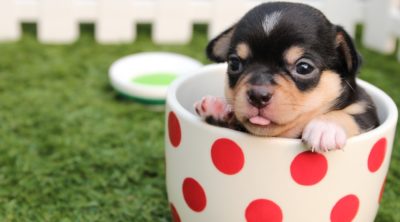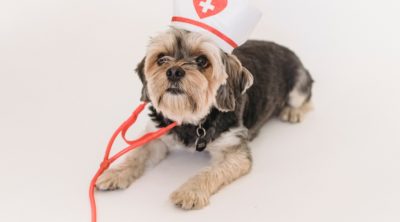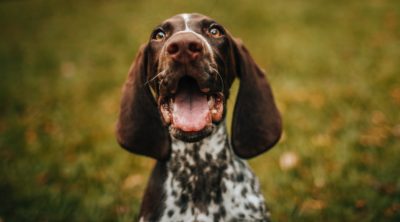
Dog anatomy is not very difficult to understand if a labeled diagram is present to provide a graphic illustration of the same. That is exactly what you will find in this DogAppy article. It provides information about a dog’s skeletal, reproductive, internal, and external anatomy, along with accompanying labeled diagrams.
After mating, dogs experience something called a copulatory tie, wherein they remain in the coital position. The male dog dismounts the female at this time. The dogs can remain in this position from a few minutes to an hour, and it is recommended not to try and separate them as it can cause injury to their organs.
A dog’s anatomy is not very different from any other mammal’s. When the pups are born, they have all the bones, muscles, and tendons that an adult dog has. As they grow bigger in size, the number of these bones, muscles, or tendons does not increase; only the tissue’s size does. The anatomy of a dog includes its skeletal structure, reproductive system, the internal organs, and its external appearance. The following paragraphs explain all these aspects in brief, along with diagrams, which will help you understand them better.
External Anatomy

Dogs, like all mammals, have eyes, a nose, a forehead, and ears. The only difference is that their noses are cold and wet, and their ears can be either dropped, erect, or cropped, depending on the breed. They also have a throat, a flew (the upper lip), chest, fore and hind legs, back, stomach, buttocks, and a tail. Some dogs have a fifth toe called the dewclaw. It is seemingly useless, but some dogs use it to strengthen their grip on whatever that they are holding between their legs. In some breeds, the dewclaw touches the ground when the dogs walk, but in most cases, it is not of much use. The external anatomy of a dog is quite simple to understand. The following diagram and paragraph attempt to explain it in brief.
The muzzle is of varying lengths, depending on the breed. Whiskers, present on the muzzle, are of some sensory use. Dogs also have a ‘stop’ on their heads, which is the point where the muzzle ends and the forehead begins. It is quite prominent in some breeds, but barely visible in others. Dogs have dichromatic vision, and they cannot see the colors green and red. They have a very sharp sense of hearing and smell. They can hear sounds that are undetectable to the human ear. As compared to the 2 to 3 million scent glands that humans possess, dogs have between 200 to 300 million. The tail set is from where the tail begins. Some dogs have high-set tails, while some have low-set tails. Like the elbow on the foreleg, there is a hock present on the hind leg. It is a joint which juts in an outward direction.
Internal Anatomy

Spinal Column – It consists of all the vertebrae and forms a part of the nervous system.
Trachea – The trachea is actually a tube that transports inhaled air to the lungs.
Esophagus – It is the tube that connects the throat to the stomach, thus, aiding in transporting food for digestion.
Larynx – It houses the dog’s vocal cords.
Heart – As in humans, this organ performs the function of pumping blood throughout the body.
Lungs – They perform the function of exchange of gases, helping the dog in the process of respiration.
Liver – It performs the function of producing bile and aiding in the process of digestion.
Kidney – The kidney filters the blood and purifies it of all the toxins that are harmful for the dog.
Stomach – The stomach is located between the esophagus and the intestine. It is the organ which breaks down the food and mixes it with the digestive juices.
Intestine – It aids in the process of digestion. It consists of the small and large intestine. The small intestine breaks the food down, whereas the large intestine stores the stool.
Spleen – It produces red blood cells, filters and removes old cells, stores the red cells, and forms an integral part of the immune system.
Bladder – It stores the urine until it is eliminated.
Rectum – It is an organ located at the end of the large intestine, which expels stool.
Reproductive Anatomy
Female Dog

The female dog goes through a heat cycle every 6 months to one year. There is a great variation in the time between each cycle, depending on the breed and the individual dog. Typically, there are four stages in the female dog’s heat cycle. It is only during the second stage that the female dog allows copulation.
The first stage is called proestrus, which is the beginning of the heat cycle. During this stage, the dog’s vulva appears swollen, and there is a bloody discharge. This stage can last between 5 to 9 days. The second stage is the estrus, wherein the reproduction process takes place.
A female dog’s reproductive system involves the uterus, the cervix, the oviducts, the ovaries, and the vagina. The ovaries are the organs that are responsible for the production of unfertilized eggs in the female. They also play a very important role in sustaining the pregnancy. The unfertilized eggs then pass to the oviduct. The oviducts are thin tubes in which the process of fertilization of the eggs by the sperm takes place. The fertilized eggs, known as zygotes, are then transported to the uterus, where their placentas stick to its walls. The zygotes mature, become embryos, and then become fetuses. The uterus is also made up of the three parts: the right uterine horn, the left uterine horn, and the main uterine body. The uterine horns are the place where the Fallopian tubes and the uterus attach.
The third stage in the female’s estrous cycle is the diestrus stage, where the female is either pregnant or experiences pseudo-pregnancy. If the dog is pregnant, then she goes into gestation (the time between conception and birth). The gestation period of dogs is between 60 to 65 days, after which the pups are born. However, as the hormonal changes during the diestrus period are the same whether the dog is pregnant or not, she can also have a pseudo-pregnancy, wherein she goes through all the physical changes related to a pregnancy, like enlarged mammary glands, milk production, weight gain, and nesting tendencies.
Male Dog

Unlike the estrous cycle in female dogs, male dogs do not go through any cycle for the purpose of reproduction. The organs that are crucial to the process of reproduction in male dogs are the testicles, the prostate gland, the penis, and the vas deferens. The vas deferens is a muscular tube that starts from the back of the testicles and goes into the pelvic cavity. Its job is to transport sperm to the urethra. The prostate gland is located under the bladder. It performs to allow mixing of prostatic fluid with the sperm.
The sperm originates, or is prepared, in the testicles. When the dog ejaculates, the sperm goes through the vas deferens, into the prostate gland, where it combines with the prostatic fluid. From there, it goes to the urethra, and is then expelled from the dog’s body through the penis. The penis contains two sections: the bulbous glandis or glans penis, and the os penis. The os penis is actually a bone inside the penis, which helps the dog achieve successful intercourse, whereas the glans penis helps the dog sustain the intercourse. It does so by filling up with blood and increasing in size, thus preventing the penis from exiting the vulva. This raises the chances of a successful fertilization.
Skeletal Anatomy

The average number of bones in a dog’s body are 321. The number will differ according to the length of the individual dog’s tail. As with all living beings, the bones surround and protect the internal organs of the body from injury. They are hard, rigid, and are made up of calcium and phosphorous. The following diagram and paragraphs explain the skeletal anatomy of a dog.
One extremely important part of a dog’s skeletal anatomy is the skull. It is a long bone structure that encases the brain, and contains a cavity called the orbit, where the eye is located. It is elongated and extends to the end of the muzzle. Next comes the vertebra or spine. It is divided into five parts: the cervical, dorsal, lumbar, sacrum, and caudal vertebrae. It has 30 vertebrae, of which 7 are cervical, 13 are dorsal, 7 are lumbar, and 3 are sacral. The cervical vertebrae are those of the neck, which follow the skull. The dorsal, lumbar, and sacrum vertebrae follow, respectively. The caudal vertebrae are the bones of the tail. The rib cage is located under the vertebra.
The lower side of the muzzle is called the lower maxillary. At the base of the cervical vertebrae and just before the rib cage is the shoulder bone, which is called the scapula. This further extends to the humerus, which is the upper half of the foreleg. It further extends down to a pair of bones, known as the ulna and the radius, which form a part of the lower half. Then comes the wrist bone, called the carpus, the paw bone which joins the wrist and the toes, known as metacarpus, and then the toe bone, known as the phalange. The rear legs of the dog begin with the femur bone, which extends to a pair of bones known as the tibia and the fibula. These further extend to the heel bone, known as tarsus, the paw bone, known as metatarsus, and the toe bone, phalange.


